Aquatic Vegetation Management Plan Project
December 22, 2025
Our Aquatic Vegetation Management Plan aims to monitor plant life within Clear and Round Lakes for improved aquatic habitat and lake-ecosystem function. Plant life is monitored throughout the year and mapped each spring and fall to make informed decisions on management and treatment plans. After reducing an invasive watermilfoil influx of 110 acres in 2022, focus remains on managing the ongoing threat of invasive species. Much of this progress has resulted from utilizing ProcellaCOR. Many state agencies have released statements supporting the use of this compound for controlling invasive watermilfoil while posing no threat to public health including Minnesota, Vermont, Wisconsin, and Connecticut.
Update 40 December 22, 2025
We would like to thank all who attended the public meeting on December 18th. Scott Banfield shared the progress in reducing invasive watermilfoil over the past few years and what we might expect to see in the coming years. If you were unable to attend the meeting, a copy of the slide presentation is available [here.] If you have questions about the presentation materials or management plans, you can email Scott Banfield at sbanfield@aquaticenhancement.com or Caroline Barth at director@clearlakeconservancy.org.
After the meeting, attendees were asked to complete a survey providing more information on lake use to include in our future planning. We welcome additional survey responses until January 15, 2026. Find the survey here.
Update #39 December 18, 2025
Join Scott Banfield from Aquatic Enhancement & Survey to learn about the types of plants found within Clear Lake and the progress on invasive species management in 2025.
The meeting will be held at Clear Lake Town Hall and on Zoom.
We will review the different species of aquatic plants within the lake over the past few years and how the native plant community has improved since this project began in 2020.
If you will be attending in person, no RSVP is needed. If you will be attending by Zoom, email info@clearlakeconservancy.org to receive the Zoom Link.
Update #38 September 10, 2025
The fall 2025 treatment of 25 acres of invasive watermilfoil has been completed. We expect a decrease of invasive watermilfoil within treated areas over the next few weeks. As this space opens up on the lake floor, native vegetation may begin to spread, especially those plants which continue to grow under the ice during winter months. Monitoring will continue through the upcoming months and a survey with mapping will be conducted again in the spring.
Please be aware of the water use restrictions listed below for areas within 100 feet of a treatment zone. With questions, contact our office at 260-527-1072 or info@clearlakeconservancy.org.
Update #37 September 9, 2025
Reminder: The treatment of 25 acres of invasive watermilfoil will be completed today by Aquatic Enhancement and Survey (AES) under permit and guidelines of the Indiana Department of Natural Resources. The following water use restrictions will be in effect near any lakefront properties that are within 100 feet of a treatment area and marked with a yellow flag posted in the lakeside front yard by AES on the day of treatment. See update 36 below for the invasive watermilfoil survey/treatment area map.
No turf irrigation – 0 days (does not affect grasses)
No irrigation of shrubs, ornamentals, garden plants – 10 days
No livestock watering – 30 days
No swimming – 1 day*
*The one day “no swimming” is not required per the label on ProcellaCOR. AES takes this extra measure for the benefit of the community.
Update #36 September 5, 2025
Our Aquatic Vegetation Management Plan aims to monitor plant life within Clear and Round Lakes for improved aquatic habitat and lake-ecosystem function. Plant life is monitored throughout the year and mapped each spring and fall to make informed decisions on management and treatment plans. After reducing an invasive watermilfoil influx of 110 acres in 2022, focus remains on managing the ongoing threat of invasive species.
This year's fall mapping was conducted on August 8 and Tier II survey on August 22, 2025 by Scott Banfield of Aquatic Enhancement and Survey. Invasive watermilfoil was detected in 25.37 acres within Clear and Round Lakes.
Looking back, the results of our fall 2024 treatment led to only 2 acres identified in the May 2025 survey and treatment was deemed unnecessary. Growing to 25 acres in just three months, we continue to note the importance of strategic management to prevent a full influx. On the bright side, Scott noted again this year the presence of many native plant species within the lakes and a diverse vegetation community.
The map below shows the location of invasive watermilfoil on August 8, 2025.
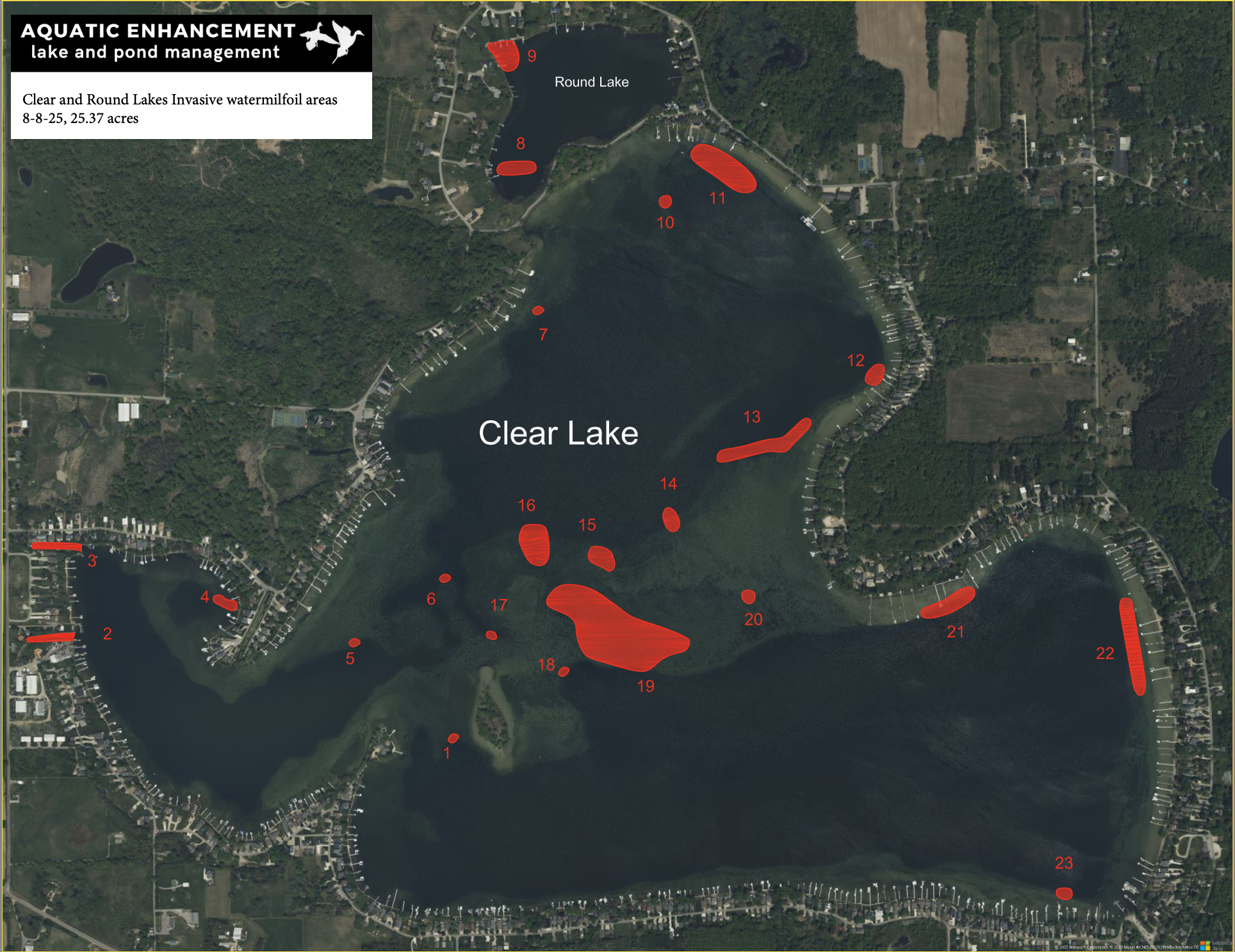
Why do we continue seeing invasive watermilfoil growth? Once present in the lake, any amount of invasive watermilfoil can spread quickly. It continues to grow and migrate to areas of the lake as recreational activity or aquatic animals cause fragmentation. As with many invasive species, it is difficult to completely eradicate, but persistent monitoring and treatment can keep populations low.
A treatment for invasive watermilfoil is planned for Tuesday, September 9th under permit of Indiana Department of Natural Resources. This treatment will utilize ProcellaCOR, a selective herbicide which targets invasive watermilfoil while having little to no effect on nearby native plants. Previous use of ProcellaCOR on our lakes have resulted in successful reductions of invasive watermilfoil.
On September 9th, the following water use restrictions will be in effect near any lakefront properties that are within 100 feet of a treatment area shown in red on the map. Homes within this restriction area will be marked with a yellow flag posted in the lakeside front yard by Aquatic Enhancement and Survey on the day of treatment.
No turf irrigation – 0 days (does not affect grasses)
No irrigation of shrubs, ornamentals, garden plants – 10 days
No livestock watering – 30 days
No swimming – 1 day*
*The one day “no swimming” is not required per the label on ProcellaCOR. AES takes this extra measure for the benefit of the community.
Update #35 June 10, 2025
The Aquatic Vegetation Management Plan continued this spring with a survey of invasive watermilfoil within Clear and Round Lakes. These surveys provide updated information for informed decisions on maintaining a healthy aquatic vegetation community.
Our spring survey of aquatic vegetation within Clear and Round Lakes was completed on May 24 and 25 by Aquatic Enhancement and Survey. We are pleased to share the low presence of invasive watermilfoil on Clear and Round Lakes totaling only 2.03 acres this spring. From 110 acres in 2022 to less than 30 acres in 2023 and 2024, the persistent and strategic control efforts have proven successful in limiting growth of this invasive species. Seasonal weather changes, temperature fluctuations, and sunlight exposure may also impact the growth patterns of invasive watermilfoil.
After discussion with our aquatic vegetation team, we will not pursue a spring treatment of invasive watermilfoil at this time. However, we will continue to monitor and map the aquatic vegetation throughout the summer and fall seasons. We will update the community as monitoring continues and future treatment plans are discussed in late summer or early fall.
Image Below: Invasive watermilfoil survey map from May 25, 2025. Red areas indicate a sighting of invasive watermilfoil.
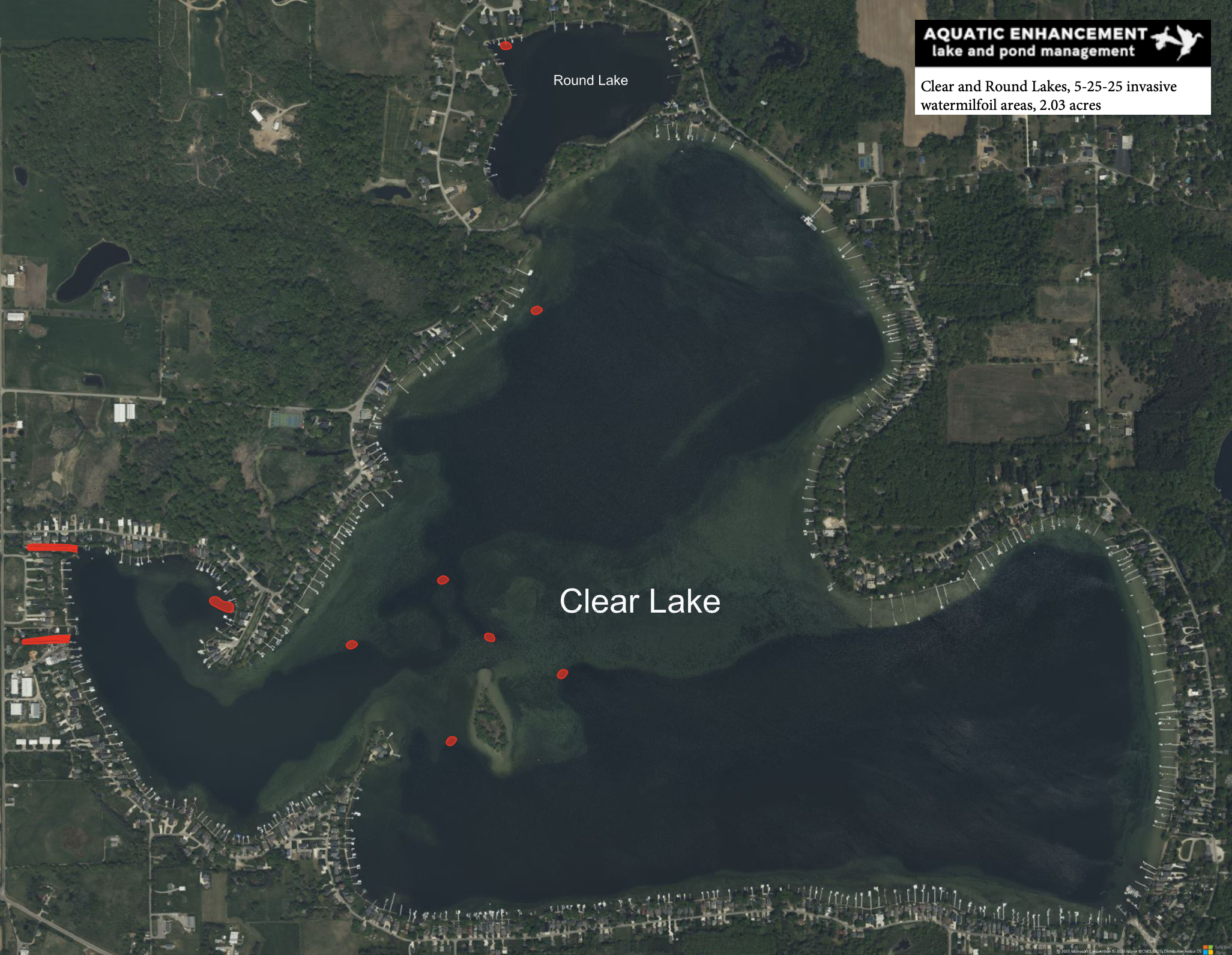
Alongside invasive watermilfoil, we have been monitoring the growth of invasive curly-leaf pondweed. In comparison to invasive watermilfoil, the spread of curly-leaf pondweed has not yet been a cause for concern. Our spring 2025 survey indicates only 12.5 acres of curly-leaf pondweed, similar to 12.8 acres found in the spring 2024 survey. There are no plans for treatment of curly-leaf pondweed at this time, but the growth will continue to be monitored as part of our ongoing Aquatic Vegetation Management Plan.
Image Below: Invasive curly-leaf pondweed survey map from May 25, 2025. Yellow areas indicate a sighting of curly-leaf pondweed.

The control of invasive aquatic vegetation proves challenging in all water bodies. However, our persistent efforts and community support have led to promising results and significant progress through the years. As we carry on with our Aquatic Vegetation Management Plan to survey and map vegetation growth each year, we strive to maintain a healthy balance of native plants, food resources, and habitat within our lakes. We appreciate the interest and support of the public and donors in carrying out this ongoing project.
Update #34 November 25, 2024
We would like to thank all who attended the public meeting on November 14th. Scott Banfield shared our progress and goals for next year regarding our aquatic vegetation management plans. If you were unable to attend the meeting, a recording is available here.
After the meeting, attendees were asked to complete a survey providing more information on lake use to include in our future planning. We welcome additional survey responses until December 10, 2024. Find the survey here.
Update #33 November 1st, 2024
We will be holding a public meeting on November 14, 2024 at the Clear Lake Town Hall and on Zoom at 7:00 PM EST for a brief presentation followed by a question-and-answer forum with Scott Banfield from Aquatic Enhancement & Survey about the our progress with aquatic vegetation monitoring and management.
To attend this meeting by Zoom, please email info@clearlakeconservancy.org to receive the Zoom meeting information.
The meeting will be recorded and made available.
Update #32 September 6th, 2024
The treatment of invasive watermilfoil on September 4th was completed as planned. Please note: water use restrictions are only in effect for lakefront properties within 100 feet of a treatment area marked by a yellow flag in the lakeside front yard on the day of the treatment.
Aquatic Enhancement and Survey will continue to monitor the growth of our aquatic plant community through the season. We will schedule a public meeting with Scott Banfield to share updates and progress later in the fall.
Update #31 September 4, 2024
Reminder: The treatment of 28 acres of invasive watermilfoil will be completed today by Aquatic Enhancement and Survey (AES) under permit and guidelines of the Indiana Department of Natural Resources. The following water use restrictions will be in effect near any lakefront properties that are within 100 feet of a treatment area and marked with a yellow flag posted in the lakeside front yard by AES on the day of treatment. See update 30 below for the invasive watermilfoil survey/treatment area map.
No swimming: 1 day
No livestock watering for: no restriction
No use of water for turf irrigation for: no restriction
No use of water for garden/ornamental irrigation for: 21 days
Update #30 August 29, 2024
We completed the fall aquatic plant species survey and mapping on August 14 with Scott Banfield of Aquatic Enhancement and Survey. While we noted the diverse native plant community, certain shoreline areas and small pockets of invasive watermilfoil were found to total just under 28 acres. Scott commented on the growth this summer: "By June we began to observe some new areas of invasive watermilfoil growth totaling 8.72 acres. Plant surveys performed in early August showed that invasive watermilfoil only occurred at about three percent of sampling sites on both lakes, showing that overall, it’s was a relatively small part of the lake’s plant communities. Later in August we spent several days on the lakes again and noted that the total area of invasive milfoil growth on both lakes had grown to 27.5 acres."
Why are we seeing more growth now compared to this past spring? Invasive watermilfoil continues to grow and migrate to other areas of the lake as boat propellers cause fragmentation and boats launched into the water may be carrying invasive watermilfoil. As with many invasive species, it is difficult to completely eradicate but persistent monitoring and treatment can keep populations low. After the last fall treatment, Scott Banfield expected around 30 acres of growth this season.
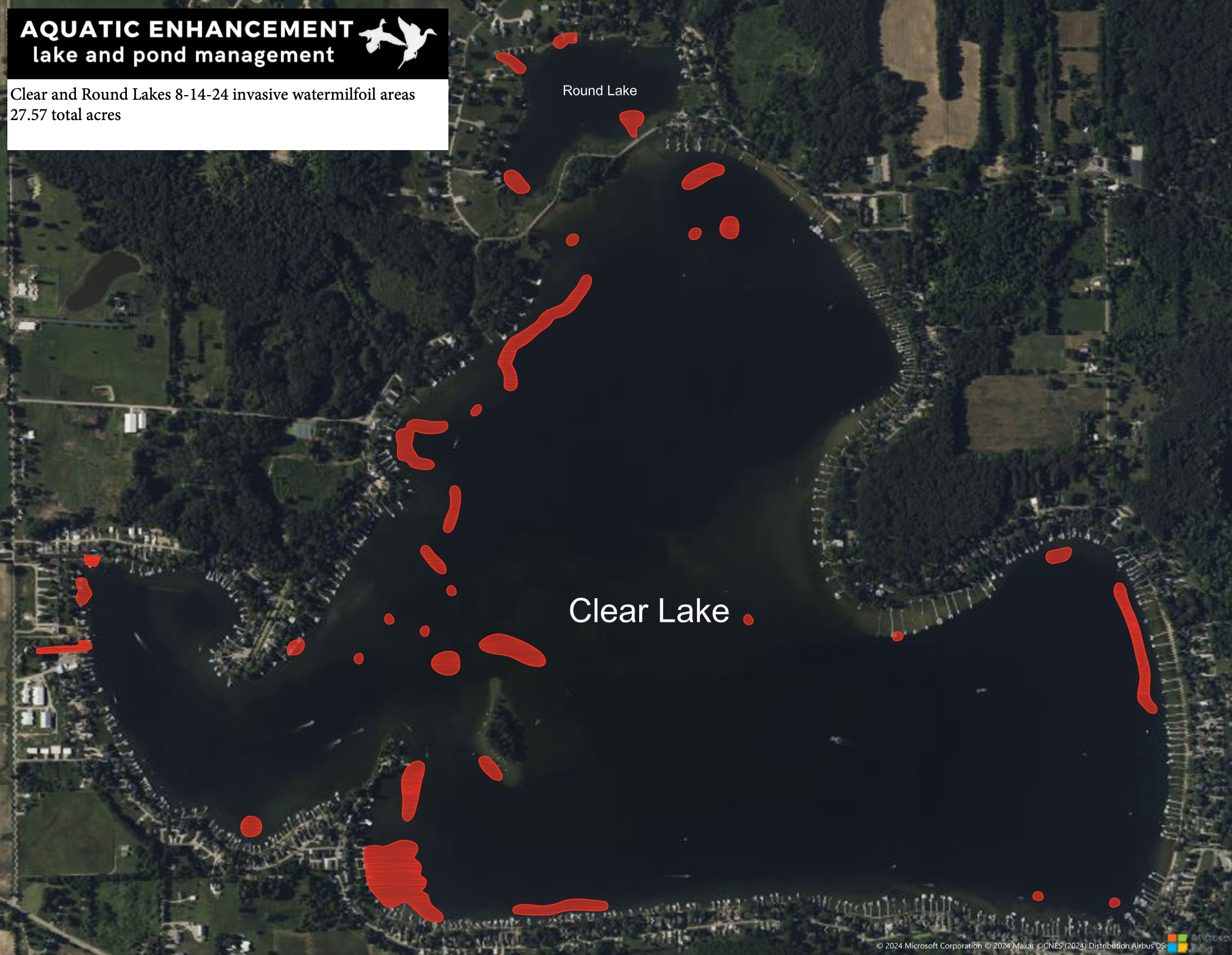
A treatment is scheduled for Wednesday, September 4th. The treatment, under permit of Indiana Department of Natural Resources, will utilize 2,4-D aquatic herbicide, favored for its ability to selectively target the invasive watermilfoil while having no effect on most native aquatic plant species. On September 4th, the following water use restrictions will be in effect near any lakefront properties that are marked with a yellow flag posted in the lakeside front yard by AES on the day of treatment.
No swimming: 1 day
No livestock watering for: no restriction
No use of water for turf irrigation for: no restriction
No use of water for garden/ornamental irrigation for: 21 days
Update #29 May 10, 2024
The treatment on April 29th, 2024, was carried out as planned.
If you have a yellow flag in your lakeside yard, be aware of the remaining period of water use restrictions listed in Update 28. The growth of invasive watermilfoil and curly-leaf pondweed will be monitored through the summer with a full survey again this fall.
If you have any questions, feel free to contact our office at info@clearlakeconservancy.org or 260-527-1072.
Update #28 April 29, 2024
If you see a yellow flag in your lakeside yard today, you are within 100 feet of the invasive vegetation treatment done by Aquatic Enhancement & Survey this morning. The following water use restrictions are in effect where the yellow flags are found.
No swimming: 1 day
No livestock watering for: 1 day
No use of water for turf irrigation for: 5 days
No use of water for garden/ornamental irrigation for: 5 days
Update #27 April 23, 2024
We recently completed the Spring aquatic plant species mapping (survey) of Clear and Round Lakes with Scott Banfield at Aquatic Enhancement and Survey. The progress over the past two years of treating the aquatic invasive plant threats in the lakes is evident. Our spring mapping this year shows just 1 acre of invasive watermilfoil growth and just under 13 acres of invasive curly-leaf pondweed.

With the small amount of growth we have this spring, a spot treatment of the invasive watermilfoil and curly-leaf pondweed is recommended to protect our progress against these invasive threats and reduce the chances of continued growth throughout the summer. This early spring treatment will reduce the propagation of invasive watermilfoil and target the curly-leaf pondweed before the turions (seeds) form and bury into the sediment.
A treatment is scheduled for Monday, April 29th. The treatment involves minimal amounts of chelated copper and diquat. On April 29th, the following water use restrictions will be in effect near any lakefront properties that are marked with a yellow flag posted in the lakeside front yard by AES on the day of treatment.
- No swimming: 1 day
- No livestock watering for: 1 day
- No use of water for turf irrigation for: 5 days
- No use of water for garden/ornamental irrigation for: 5 days
Update #26 December 7, 2023
Our most recent community meeting with presenter Scott Banfield from Aquatic Enhancement & Survey was both well attended and informative. Those who could not attend are encouraged to view the recording to learn more about our most recent year of treating aquatic invasive species and potential directions moving forward.
During the meeting, the community was invited to complete a survey to better understand how the lake is being used by each household. Please fill out the survey linked below to help us update the Aquatic Vegetation Management Plan Draft for 2024. Surveys will be accepted through December 31, 2023.
Update #25 November 16, 2023
We will be holding a public meeting tonight at the Clear Lake Town Hall and on Zoom at 7:00 PM EST for a brief presentation followed by a question-and-answer forum with Scott Banfield from Aquatic Enhancement & Survey about the recent aquatic plant treatment and what we may expect moving forward.
We look forward to sharing information about our Aquatic Vegetation Management Plan from this past season and how this project may continue moving forward.
Click here to attend virtually.
The meeting will be recorded and made available.
Update #24 October 11, 2023
The treatment on September 27th, 2023, was carried out as planned. While the population of invasive watermilfoil may never be fully eradicated, the success of the ProcellaCOR treatment approach has met and exceeded expectations. From almost 110 acres of invasive watermilfoil in 2022 to 26 acres in the spring of 2023 to less than 4 acres in the fall of 2023, we are very pleased with the outcome. We are happy to finalize our ProcellaCOR recent journey with such a low population of the invasive watermilfoil.
As is the case with most freshwater lakes, we should always be prepared to begin another battle of an invasive species at any moment. We plan to continue surveying the aquatic vegetation in Clear and Round Lakes and detailing the profile of the plant community. We will continue to update the public with our findings.
Join us on Thursday, November 16th at 7:00 PM for a question-and-answer forum with Scott Banfield from Aquatic Enhancement & Survey about the recent treatment and what we may expect moving forward.
We will meet at the Clear Lake Town Hall and on Zoom.
Click here to attend virtually
Update #23 September 27, 2023
If you see a yellow flag in your lakeside yard today, you are within 100 feet of the Eurasian watermilfoil treatment done by Aquatic Enhancement & Survey this morning. The following water use restrictions are in effect where the yellow flags are found.
- No turf irrigation - 0 days (does not affect grasses)
- No irrigation of shrubs, ornamentals, and garden plants - 10 days
- No livestock watering - 30 days
- No swimming - 1 day*
*The one day "no swimming" is not required per the label on ProcellaCOR. AES takes this extra measure for the benefit of the community.
Update #22 September 20, 2023
Plant surveys were completed on Clear and Round Lakes on August 23rd by our consultant, Aquatic Enhancement & Survey (AES). These surveys utilized the same survey protocol used during the past several assessments. On Clear Lake, 100 sites were rake-toss sampled and on Round Lake, 30 sites were rake-toss sampled. We were glad to see that the invasive watermilfoil we’ve been working to control did not occur at any of the sampling sites on either lake. This shows that, statistically speaking, the invasive watermilfoil is not currently a significant part of the plant community at either lake. Following the plant surveys, AES used a thorough visual inspection of the shallower areas of the lakes to see if any of the invasive watermilfoil could be located. They were able to confirm a small amount remaining; a total of 3.92 acres pictured below.
Surveys have confirmed that the recent ProcellaCOR treatments were extremely successful, with an almost 85% reduction in the invasive watermilfoil population. However, to proactively work toward sustained control, it has been recommended by AES that another treatment be applied before the end of the 2023 summer season to address the few areas where the invasive milfoil was noted. This treatment would fall within our current Indiana Department of Natural Resources (IDNR) permit regulations for 2023 ProcellaCOR application. To stay within the warm season and the permit window, the treatment must be applied before the end of September.
This treatment utilizing ProcellaCOR herbicide will be applied on September 27th by Scott Banfield from AES. The treatment will be applied to the red areas on the map. The water use restrictions following this application will be active for all locations within 100 feet of the treated area. We will continue to update the community as the process continues. A public meeting is being scheduled with Scott Banfield from AES to communicate the findings to the community, likely in November.
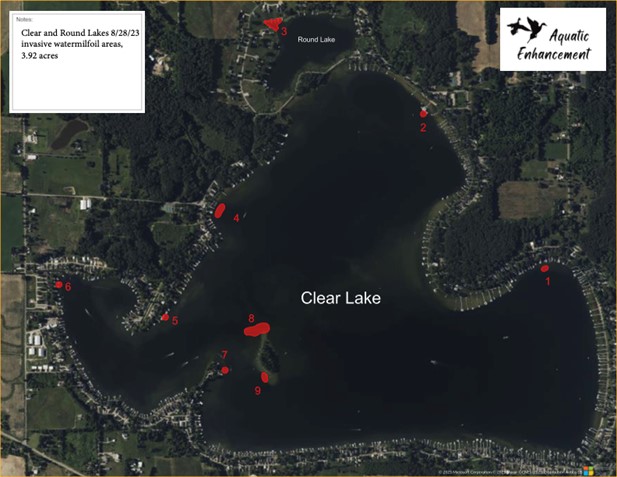
The following water use restrictions will be in effect near any lakefront properties that are marked with a yellow flag posted in the lakeside front yard by AES on the day of treatment.
1) No turf irrigation – 0 days (does not affect grasses)
2) No irrigation of shrubs, ornamentals, garden plants – 10 days
3) No livestock watering – 30 days
4) No swimming – 1 day*
*The one day “no swimming” is not required per the label on ProcellaCOR. AES takes this extra measure for the benefit of the community.
Update #21 June 13, 2023
The Eurasian watermilfoil treatment by Aquatic Enhancement & Survey (AES) on Monday, June 12th went as planned. About 26 acres in Clear Lake and Round Lake were treated. The water-use restrictions are now in effect. AES will survey the lakes again in July and report findings.
The following water use restrictions are in effect near any lakefront properties that have a yellow flag posted in the lakeside front yard by AES.
1) No turf irrigation - 0 days (does not affect grasses)
2) No irrigation of shrubs, ornamentals, garden plants - 10 days
3) No livestock watering - 30 days
4) No swimming - 1 day*
*The one day "no swimming" is not required per the label on ProcellaCOR. AES takes this extra measure for the benefit of the community.
Update #20 June 4, 2023
We are making progress on the treatment of Eurasian Watermilfoil as we start Year#2 of the long-range Aquatic Vegetation Management Plan. We are again working with Scott Banfield and Aquatic Enhancement & Survey (AES) to track and manage several invasive aquatic plants growing in our lakes. The red areas on the map below represent the current invasive watermilfoil growth on Clear and Round Lakes. In the spring of 2022, AES noted about 110 acres across both lakes. Due to last year's treatment efforts, we are down to about 26 acres across both lakes this spring.
AES will be focusing on treating all 26 acres of remaining invasive watermilfoil on Monday, June 12th. The Indiana Department of Natural Resources (IDNR) has issued a permit for this treatment using the chemical ProCellaCOR. AES believes this planned treatment will keep this plant well under control this season.
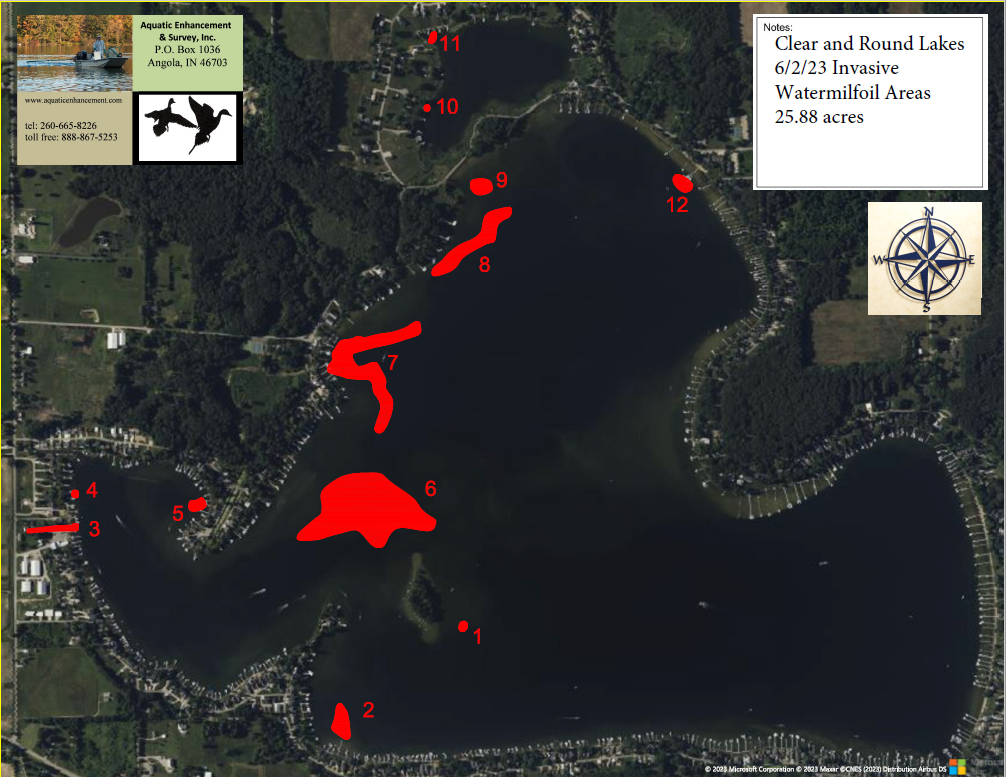
Update #19 June 2, 2023
Treatment is planned for Monday, June 12th.
Aquatic Enhancement & Survey is working to complete their suvey work identifying the invasive Eurasian watermilfoil areas on Clear and Round Lakes. Look for an updated treatment map and guidelines coming soon.
Update #18 December 8, 2022
A community meeting was held with presenter Scott Banfield from Aquatic Enhancement & Survey to give updates on the treatment of Eurasian watermilfoil and other invasive aquatic plants on June 1, 2022, follow-up survey results, and the recommended treatment plan for 2023. If you missed the meeting you can view the Zoom recording.
During the meeting the community was invited to complete a survey to better understand how the lake is being used by each household. Please fill out the survey linked below to help us update the Aquatic Vegetation Management Plan Draft for 2023. Surveys will be accepted through December 31, 2022.
The current draft of the Aquatic Vegetation Management Plan can be found here. If you have any questions email Scott Banfield at sbanfield@aquaticenhancement.com or contact the Conservancy at (260) 527-1072 or email us at info@clearlakeconservancy.org.
Update #17 November 8, 2022
Join us on Tuesday, December 6, 2022 at 6:30 pm to hear from Scott Banfield from Aquatic Enhancement & Survey about the June 1 herbicide treatment, follow up survey results, and plans for 2023 treatment.
We will meet at the Clear Lake Town Hall and on Zoom.
This is your chance to ask questions and find out what you can do to help eliminate this invasive aquatic plant.
Click here to attend virtually>>
The meeting will be recorded and made available.
Update #16 July 22, 2022
The Eurasian watermilfoil treatment was completed on June 1. The contractor checked the treatment areas on Clear and Round Lakes. He reports there's less than one acre of invasive milfoil left standing. A small patch was found in Marina Bay. The big question now is how much will emerge next spring? The areas previously colonized by the invasive milfoil contain mostly native pondweeds now, which is encouraging.
It's important to note that in the central flat on Clear Lake the milfoil has largely been replaced by densely growing sago pondweed, a favored food of many waterfowl. Many of these plants are on or near the surface, so boat traffic will still be producing prop-cuts and possibly fouling their props if they are moving through this area.
Concerns were raised about possible effects on native plants at Round Lake, but overall vegetation is looking pretty healthy and happy.
Aquatic Enhancement and Survey will complete a Tier II survey yet this summer and update our Aquatic Vegetation Management Plan. This along with survey work in Spring 2023 will guide the treatment efforts next May/June.
Support this project while wearing a uniquely designed t-shirt! Donate $25 for one or $40 for two! All proceeds support future treatments and survey work.

Update #15 June 24, 2022
It’s been three weeks since Aquatic Enhancement & Survey (AES) completed the treatment of 52 acres of Eurasian watermilfoil on Clear Lake and just under 7 acres on Round Lake on June 1st. Since then, we've received a few questions from the community and want to respond to the questions, update everyone on what we are seeing and describe what next steps are planned. We asked Scott Banfield of AES to respond to specific questions about treatment.
Q: We are seeing algae in Round Lake. Is the treatment responsible for this?
A. (Scott from AES). Parts of Round Lake, especially the eastern (downwind) shore, have a good bit of filamentous algae building up along the shoreline based on the photos you shared. We don't usually see an increase in filamentous algae (sometimes commonly called pond scum) in response to natural lake treatments like we performed at Round Lake but it's certainly possible the treatment contributed to a normal occurrence of this algae buildup. While filamentous algae is unsightly and can be a nuisance, it is not considered a health threat to people or animals.
Filamentous algae generally grows on the lake bottom like green fur on a normal basis. It often becomes buoyant when gas bubbles are trapped in it. After it hits the surface, prevailing winds can move it to the downwind side of the lake where it gathers along the shoreline. Usually this is a short-term situation as weather conditions and growth patterns break up the algae on the shoreline. Generally, the shoreline will return to normal as the season progresses.
It’s important to know that I receive phone calls every year from people with filamentous algae accumulating along their shoreline where they had never noticed it before. It's pretty common for this to happen both on lakes that are treated and also on untreated lakes.
It's normal to have a temporary decrease in water clarity following a treatment for aquatic plants. Decomposing plants release nutrients which can spur the growth of filamentous algae. You also might have a decrease in water clarity as a result of organic acids being released from the plants as they decompose. How noticeable these effects are depends on the size of the treatment relative to the size and volume of the lake and other factors. Because we treated a relatively large portion of Round Lake, I would expect the natural results I’ve described to be more noticeable there compared to the larger Clear Lake.
Q: We are still seeing a lot of floating plant debris. Is this from the treatment?
A. (Scott from AES). It’s natural to assume the invasive plant treatments might be causing this phenomena. However, when we treat aquatic plants they tend to drop in place and decompose rather than uprooting. We don't usually see our target plants floating on the surface of the lake after the treatment. Since we are more than 20 days beyond the treatment, none of the target plants are still green and healthy looking. Most or all of the target plants would have dropped by this point.
Since only a portion of the Eurasian watermilfoil infesting Clear Lake was treated in this first year of the treatment plan, the green plant fragments reported floating are more likely untreated prop-cut plants generated by boat traffic moving through some of the shallower areas of the lake. The best way to minimize this is for boats to navigate through the deeper areas of the lake whenever possible.
As invasive plant populations are further reduced in coming seasons, you can expect fewer floaters, but some amount of floating plant debris will likely still be around. If you look at the floating plant fragments carefully, you will see native as well as invasive plants floating. Some floaters will likely always be present in a healthy lake with a high recreational use, which is how I would describe Clear and Round Lakes.
Q. It seems like I’m seeing more dead fish than usual this year. Is this related to the treatment of the invasive aquatic plants?
A. (Scott from AES). It's natural to assume that if a lake has been treated and dead fish are seen, the fish have died as a result of the treatment. However, products used to treat aquatic plants generally have quite low toxicity to fish and other forms of aquatic life. They are engineered to be highly effective on target plants and leave other forms of wildlife unharmed. When properly performed, plant management can be quite compatible with a healthy fishery.
When it comes to dead fish on our beaches or floating in any lake, it's important to consider a couple of general observations to diagnose possible causes.
Fishkills resulting from toxic substances finding their way into the water will generally be hardest on the smallest fish. Most of the fish noted will be smaller, younger fish. If a low-oxygen situation causes a fishkill, it will typically be hardest on the largest fish. It's also important to consider the numbers of dead or dying fish present. A small number of dead or dying fish on a given day is normal, while hundreds of dead fish is more of a cause for alarm and worthy of investigation.
Seeing dead fish in lakes is pretty common in the early spring after the ice melts and it's also pretty common at this time of year (late spring, early summer). Spawning instincts and relatively rapid water temperature changes can place lots of stress on adult fish at this time of year and some number of fish are regularly lost.
Our treatment in early June went as expected and was very unlikely to be a cause of significant fishkill.
Q. Is the Indiana Department of Natural Resources (IDNR) involved in the recent treatment of invasive aquatic plants?
A. Yes. No treatment can occur without the submission of a detailed treatment plan and approval of the IDNR. The recent treatment plan was submitted to and approved by the IDNR.
Q. Is treatment really necessary? What happens if we just let nature take its course?
A. As Dr. Robin Scribailo told us at the public meeting held in October 2021, Eurasian watermilfoil is extremely aggressive and over time can crowd out all native aquatic species, changing the current ecosystem of our lakes. Recreation, fishing and boating could no longer be possible. The community survey conducted by the Conservancy last fall strongly supported pursuing treatment. Regular updates of plans and treatment notices have been posted on the Conservancy website, sent in eBlasts and posted on social media. You can review them below. Sign up here to receive regular Conservancy communications.
Q. What is the next step in the treatment plan?
A. In July-August, AES will conduct an aquatic vegetation survey. This assessment will determine the extent and location of all aquatic plants on Clear and Round Lakes, including Eurasian watermilfoil. This assessment will be reviewed by the Conservancy and AES to begin planning for 2023 and it will also be filed with the IDNR. The second treatment plan proposed must be filed with and approved by the IDNR.
We expect the second phase of treatment will start in late spring 2023, starting with a lake-wide assessment of invasive aquatic plants and followed with a late-spring treatment of additional infested areas.
Eurasian watermilfoil will likely never be fully eradicated, so we expect treatments to continue indefinitely, but at lessening levels over time.
Update #14 June 1, 2022
The battle begins...
The treatment of 52 acres of Eurasian watermilfoil on Clear Lake and 6.8 acres on Round Lake is being completed today, Wednesday, June 1st. The areas shaded in purple below are the target areas.
We can expect to see the plants begin to brown out in a few weeks and drop to the bottom as they die.
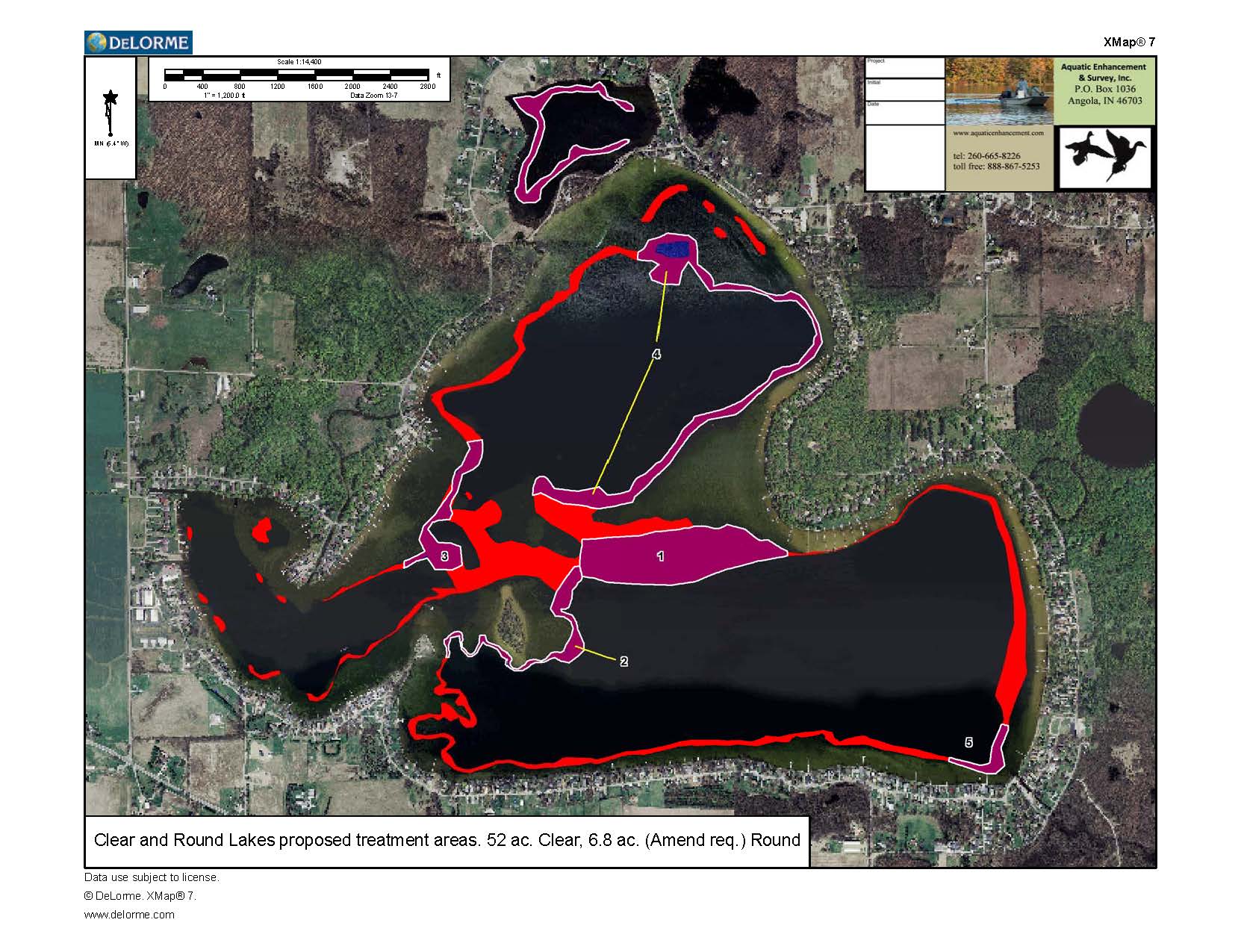
Do you see a yellow flag on your shoreline?
Water-use restrictions only apply within 100 feet of the treatment areas. Based on the above treatment map you can see there's only a handful of areas on Clear Lake where they have posted. Those include the area near the launch, Paradise Point, the South part of the Island, and a stretch of shoreline along East Clear Lake Drive. In a couple of these areas the treatment is more than 100 feet out, but it was posted anyway. All of Round Lake will be posted.
The water-use restrictions include:
1) No turf irrigation - 0 days (does not affect grasses)
2) No irrigation of shrubs, ornamentals, garden plants - 7 days
3) No livestock watering - 30 days
4) No swimming - 1 day*
*The one day "no swimming" is not required per the label on ProcellaCOR. Aquatic Enhancement & Survey takes this extra measure for the benefit of the community.

Update #13 May 25, 2022
Treatment is planned for Wednesday, June 1st.
All colored areas represent Eurasian watermilfoil growth on the map below. The Indiana Department of Natural Resources (IDNR) has permitted the treatment of 52 acres on Clear Lake using the chemical ProcellaCOR. Based on survey rake scores of 5 (high presence of EWM) and high boat traffic areas, the 2022 treatment will focus on the purple areas numbered 1 - 5 on Clear Lake.
Round Lake has slightly more EWM area (6.8 acres) than permitted (6 acres) for treatment using ProcellaCOR. Aquatic Enhancement & Survey will treat all the EWM at Round Lake if an amendment to add 0.8 acres is granted from the IDNR. If the amendment is not granted, the permitted 6 acres will be treated.

Water-use restrictions only apply within 100 feet of the treatment areas. Before treatment day, Aquatic Enhancement & Survey will post a landscaping flag detailing water use restrictions. Based on the above treatment map you can see there's only a handful of areas on Clear Lake where they will post. Those include the area near the launch, Paradise Point, the South part of the Island, and a stretch of shoreline along East Clear Lake Drive. In a couple of these areas the treatment is more than 100 feet out, but it will be posted anyway. All of Round Lake will be posted.
The water-use restrictions include:
1) No turf irrigation - 0 days (does not affect grasses)
2) No irrigation of shrubs, ornamentals, garden plants - 7 days
3) No livestock watering - 30 days
4) No swimming - 1 day*
Many thanks to the following for their project support:
Clear Lake Association, Anonymous, Ann Brennan, Jim & Karen Bushey, Sue Compo, Bill & Judy Greffin, Cindy & Steve King, Molly & Jeffrey Nagle, Matt & Claire Timmer, Denny & Sheryl Vetter, and the Lake & River Enhancement Grant program.
Update #13 May 28, 2022
We made the match! Many thanks to Jim and Annie Skinner for the $4,000 matching opportunity. And many thanks to everyone who contributed. More details to come!
Update #13 May 20, 2022
Aquatic Enhancement & Survey has completed their survey work identifying the invasive Eurasian watermilfoil areas on Clear and Round Lakes, highlighted in red on the map below.

Treatment locations and timeline to come.
Curly leaf-pondweed surveys were completed and very little was observed. This is not too surprising as curly-leaf emergence can vary significantly from year-to-year, according to Scott with Aquatic Enhancement & Survey. Growth was not significant enough to warrant treatment in 2022. Growth will be surveyed in early 2023.
Update #12 April 25, 2022
We are glad to share that Aquatic Enhancement & Survey is the contractor selected to complete the invasive species control this spring and summer. The permit application was approved by the Indiana Department of Natural Resources to treat Eurasian watermilfoil and curly-leaf pondweed in Clear Lake and Round Lake. Scott and his team have been on the lakes to assess the infestation of curly-leaf, pictured below. Check back for the timeline and treatment approach.
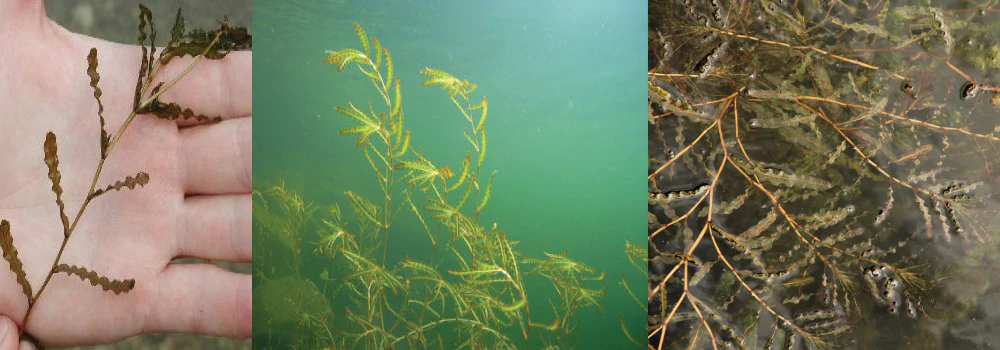
Photo credit: thepondshop.com
Update #11 March 28, 2022
The final report is available for viewing and download from the survey work completed last summer. The Aquatic Vegetation Management Five-Year Plan can be accessed here. Results from this study are important for understanding the level of infestation of invasive aquatic plants and the location.
Update #10 March 15, 2022
IDNR has awarded $8,000 through the Lake & River Enhancement Grant program to support the treatment project and follow up survey work.
Update #9 February 25, 2022
The next step will be to apply for a permit from the IDNR to complete treatment beginning in 2022. Check back for this update to learn where we will be allowed to treat, what method will be used, and when the treatments will begin.
Update #8 January 15, 2022
CLTLC's Board reviewed treatment options presented through a scoring matrix put together by members of the Water Quality Committee and Staff. Based on the scoring of safety, effectiveness and cost factors, the Board approved a treatment approach for submission to the IDNR.
An application was made to the Lake & River Enhancement grant program for funding of treatment and control of the aquatic invasive species identified in the updated AVMP from the summer of 2021.
Update #7 October 2021
A community meeting was held to share findings from the survey work. View the recording here.
The community was invited to fill out a survey to help inform the decision making process going forward.
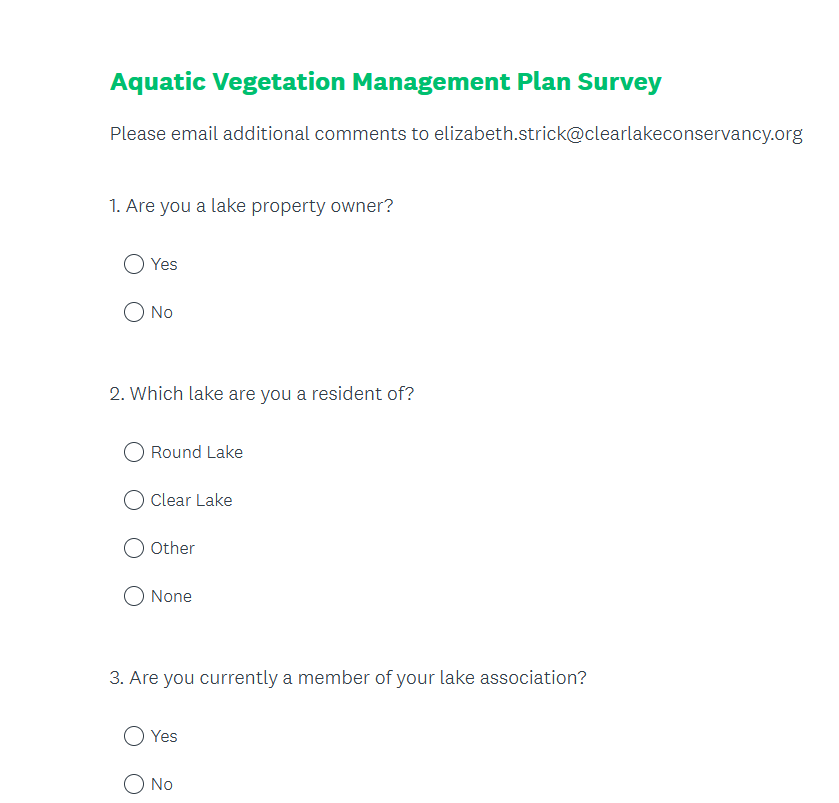
Update #6 May - August 2021
Survey work was completed by Dr. Scribailo of Aquatic Ecosystem Services to identify the location and level of infestation of the aquatic invasive plants.
Update #5 February, March, April 2021
Community support from Matt & Claire Timmer, Sue Compo, an anonymous donor, and the Clear Lake Association was secured to move forward on the AVMP project.
 We really appreciate this support!
We really appreciate this support!
The Water Quality Committee put a scope of work together for the updated AVMP project.
The project went out to bid and Aquatic Ecosystem Services was selected.
Update #4 January 2021
The Conservancy applied for Lake & River Enhancement grant to request funding to get an updated Aquatic Vegetation Management Plan (AVMP), a required step by the Indiana Deparment of Natural Resources (IDNR) in the treatment process.
Funding was denied.
Update #3 September 2020
Water Quality Member Matt Rippe uploaded GPS tracks of known and estimated sites with EWM.
Dr. Scribailo visited Clear Lake and Round Lake to help us understand the level of infestation and plan next steps.
Update #2 August 2020
Members of our volunteer Water Quality Committee collected a sample and shipped it to Dr. Robin Scribailo at Purdue University. He confirmed the presence of invasive and non-native, Eurasian Watermilfoil (EWM).
An "Ask Bridget" was sent out.
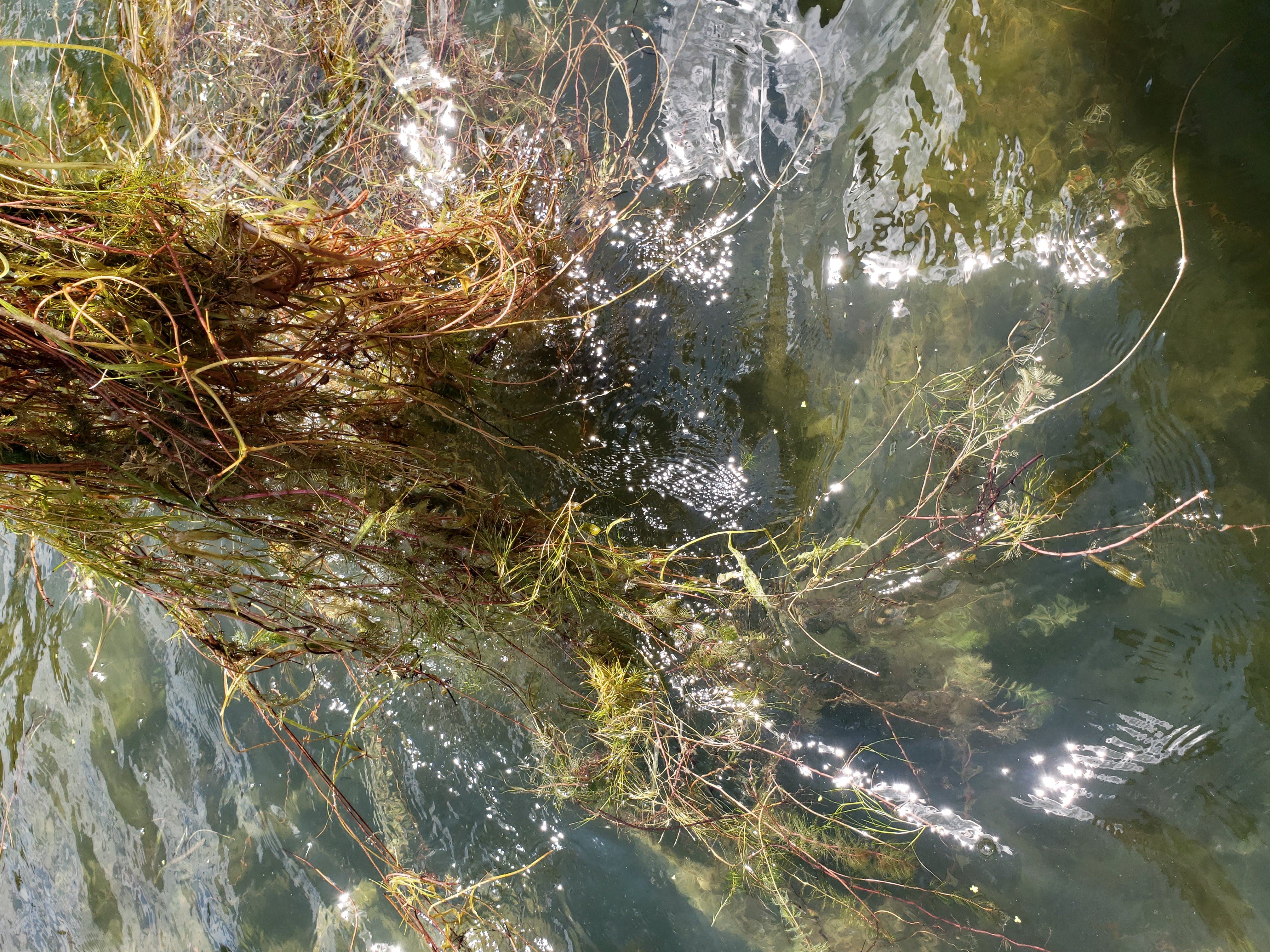
Update #1 July 2020
Bill Geiger took Bridget Harrison up in his plane to see the aerial view of the increased plant life in Clear Lake.
Connor Oiler flew his drone and collected valuable aerial footage of the location of the aquatic plants.
Several community members voiced concern.
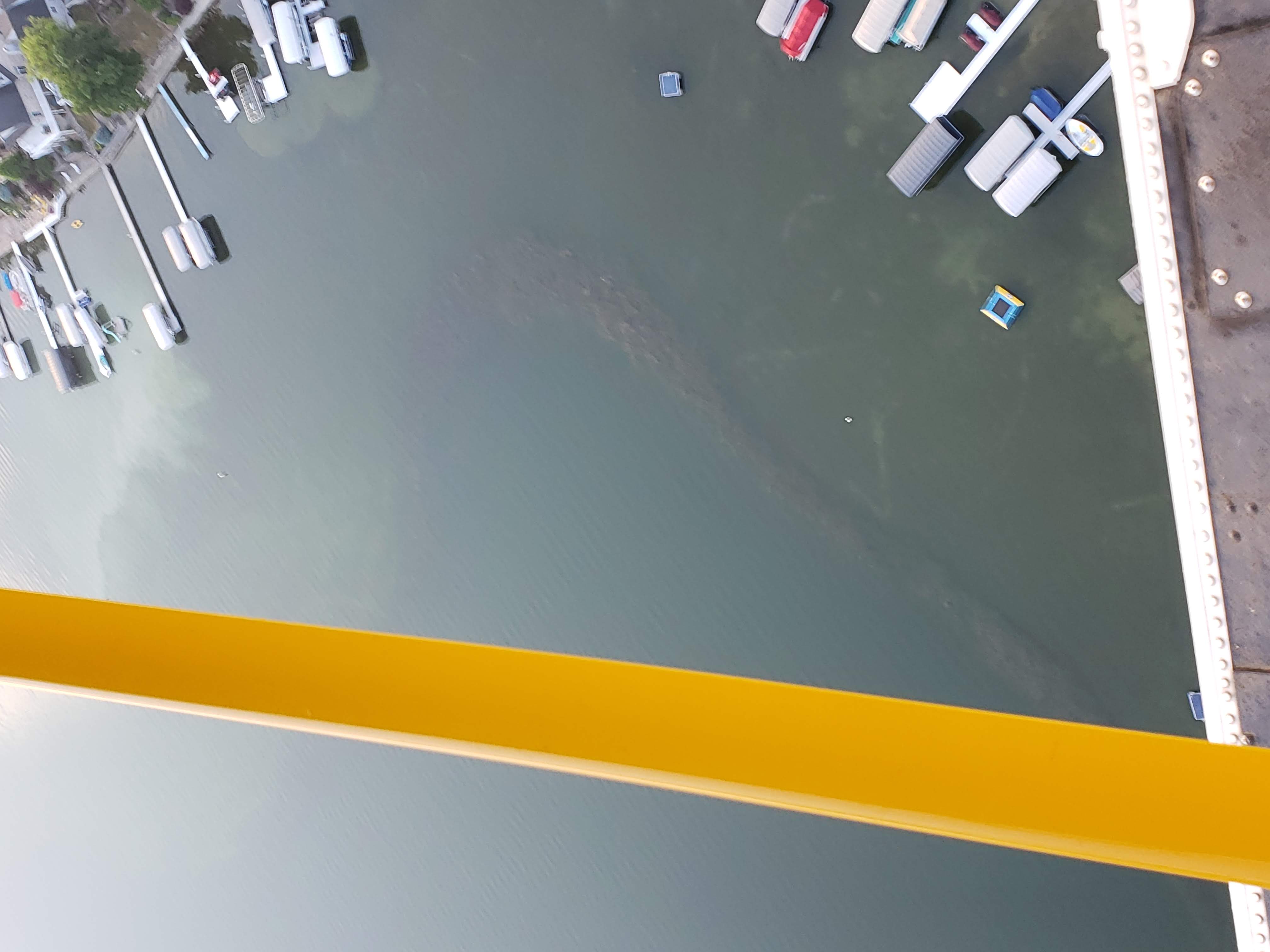
Cover photo credit: Connor Oiler
